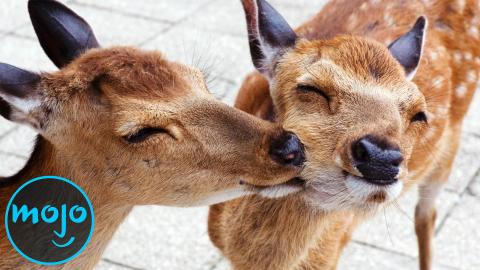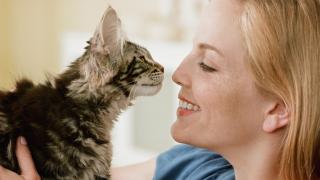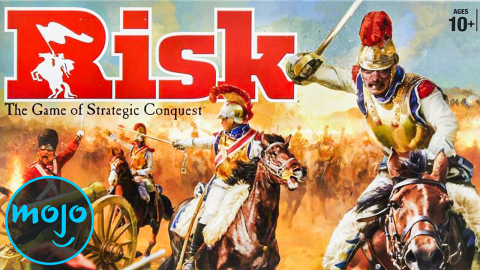Top 10 Ways Animals Look Out for Each Other

It's a dog-eat-dog world . . . but sometimes it pays to lend a helping hand. From lifelong partnerships, to unlikely friendships, to hugging and kissing, animals form bonds just like us. WatchMojo counts down the Top 10 Ways Animals Look Out for Each Other.
Top 10 Ways Animals Look Out for Each Other
Weirdest Ways Animals Communicate
It’s a dog-eat-dog world . . . but sometimes it pays to lend a helping hand. Welcome to Watchmojo.com, and today we're counting down our picks for the Top 10 Ways Animals Look Out for Each Other. For this list, we're looking at helpful animal behavior both within and across species.
#10: Lifelong Partners
Life in the animal kingdom can be solitary and short. And reproduction is often just a quick means to an end. But some animals form monogamous pair bonds for life, or at least a long time - seeing each other through thick and thin. Swan lovers migrate, nest, and raise multiple clutches of cygnets together, learning from parental success and failures. So too do wolves, who hunt and travel in nuclear families. Other animal species that mate for life include bald eagles, albatrosses, gibbons, and the king and queen in termite colonies.
#9: Grooming
Top 5 Time Saving Dog Grooming Products
Even in the great outdoors, you want to look and feel your best. But how to clean those hard to reach places? Primates pick through each others’ fur to remove ticks, dead skin, and dirt, a behaviour that reduces parasites and infection, but also establishes and reinforces social relationships in the troop - consoling upset friends and relatives, reconciling after arguments, or making romantic overtures. Animals without hands find otherways to groom: pecking, licking, or nibbling compatriots to keep their coats spick, span and glossy.
#8: Friendships Without Borders
Top 10 Board Games That Destroy Friendships
Many animals have favorites within their own kind. But now and then, animals also form friendships across species. Such unusual attachments are often forged between juvenile animals in human care, and can include species that in the wild would be natural enemies, but whose roles change in a novel environment. Kasi the cheetah and Mtani the labrador are a prime example - raised together in Busch Gardens Tampa after Kasi’s mother was unable to care for him. Then there’s Baloo the bear, Leo the Lion, and Shere Khan the tiger - rescued in 2001 from a drug dealer in Atlanta. Sometimes, opposites really do attract.
#7: Physical Affection
Quantum Light Explained | The Future Of Physical Matter | Unveiled
Life is tough, and sometimes everyone needs a good hug . . . and maybe even a kiss. Humans are far from the only animals who express themselves through touch. A number of animals, especially mammals, also engage in physical intimacy, which like grooming can build and strengthen bonds between partners, parents and children, or allies. While some cuddle, others nuzzle and rub heads - a behavior especially common between lions. Although it serves a more practical purpose, sea otters even hold hands, to keep from drifting apart as they snooze.
#6: Travel Companions
How AI Is Changing Travel
There really is safety in numbers; especially in certain mixed-species associations. In the Serengeti, a quarter of a million zebra and almost two million wildebeest migrate together each year from south to north and back again chasing the rains. The two are natural travel companions, since zebra shear through long, tough grass, while wildebeest prefer the shorter shoots underneath. But grouping together also gives them a better chance of detecting and evading predators, increasing absolute group size without also increasing intraspecific food competition, and confounding the ability of predators to accurately target individuals within the larger group.
#5: Caring for the Weak
Celebs Are Caring About YouTube? Will It Last?
Nature may be “red in tooth and claw”, but some animal species also care for the weak, sick, and helpless. Older bonobo females often help younger, harassed females and stand up to aggressive males. And dolphins have been observed lifting ill companions to the surface to breathe, sometimes for hours. Rats too can look out for the less fortunate. In a 2011 study at the University of Chicago, rats freed trapped companions even when it meant ignoring a chocolate treat. Elephants even seem to mourn their dead - standing vigil around the bodies and bones of lost calves, matriarchs, and friends.
#4: Sharing Food
When food is scarce, a meal can mean the difference between life and death. But some animals are surprisingly generous. Bonobos share food with both friends and strangers, and even chimpanzees sometimes share meat, either with social allies, or with other participants of the hunt. Wolves also spread the wealth, bringing food back to injured pack members. And in a way that’s both disgusting and . . . sweet, we guess (?) . . . vampire bats regurgitate blood to both kin and non-kin who are down on their luck. It’s a wise move in a world where next time, it could be the sharer who falls on hard times - and needs to depend on old friends.
#3: Daring Rescues
Top 10 Most Daring Rescues in History
According to the Greek historian Herodotus, when the poet Arion flung himself into the ocean to escape pirates, a dolphin beguiled by his music carried him to shore. The idea that dolphins come to the aid of humans in peril is more than legend. Dolphins have been observed lifting drowning swimmers to the surface, and rescuing others from sharks - forming protective rings or ramming the sharks to repel them. The behaviour has also been documented in other cetaceans. Humpback whales are known to intervene in killer whale attacks on other whale species, sea lions, and seals.
#2: Adoption
Life is tough for animal orphans, and their chances are often slim. But, although rare, adoption in the animal kingdom isn’t unheard of. Chimpanzees aren’t exactly known for being selfless, but both male and female chimps have been observed taking care of unrelated orphans. Walrus mothers have also been observed tending to orphaned pups, and red squirrels will sometimes take in hand those of close relatives. On occasion, domesticated dogs even take in infants of a completely different species, as do captive apes - forming sometimes unlikely bonds.
#1: The Ultimate Sacrifice
Top 10 Ways Your Pets Show You They Love You
Sometimes, a leap into danger is the only way to protect friends and family. Many bird species feign broken wings to draw predators away from their young, risking themselves in the process. Adult bonobos also put themselves in harm’s way, the males positioning themselves at the leading edge of the troop while infants cluster inside. While the alarm calls of meerkat sentries attract the attention of predators, they give others time to find safety. Few, however, can compete with the devotion of the honey bee, who will attack a perceived threat even though its barbed stinger lodges in thick skin - laying down its its life for the hive.









